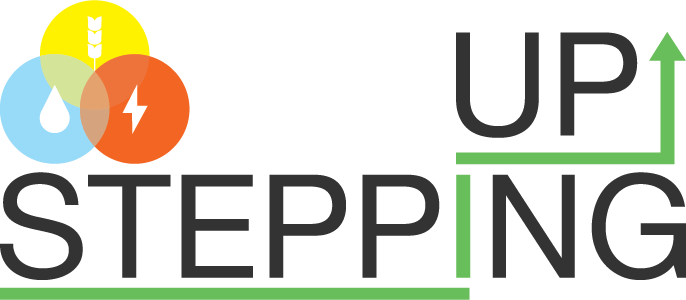You are here
What does the future hold for AD? A summary of two recent workshops

By engaging with a range of stakeholders, Stepping Up is seeking to understand how innovations shape impacts across the nexus of water, energy and food systems, today and into the future. This blog reports on two recent workshops exploring the future of one of our chosen innovations: anaerobic digestion (AD).
The value of an innovation lens for nexus studies
Analyses of innovations usually occur within the context of specific systems. For example the development of low carbon electricity technologies is frequently considered in the context of energy system actors, energy policy, and energy policy objectives. However, all innovation also has the capacity to affect the functioning of other systems of provision, such as water and food systems. ‘Nexus thinking’ around innovation thus seeks to consider how innovation processes influence, and are influenced by activities, actors and outcomes across rather than within water, energy and food systems.
Examining processes of innovation in this way can help us understand more about what effective governance of the water-energy-food nexus might look like. Employing such an innovation-centric approach, the Stepping Up project investigates how we might incorporate nexus-thinking into the governance of innovation, and by extension, the governance of complex systems more generally. This blog talks specifically to one of our chosen innovations: anaerobic digestion.
Thinking about the future
Innovation processes, as carried out by complex networks of actors, are inherently future focused. Much of innovation is concerned with the identification and realisation of opportunities. By developing expectations around these opportunities, new technologies and practices can garner interest, support, and investment. Conversely, innovations have no potential if users, financiers, policymakers etc. do not expect that they will succeed in meeting their individual requirements. As such, the development and sharing of visions of among innovation stakeholders is widely considered central to the innovation process as a whole.
Of course, innovators (in their many guises) think about the future all the time, both consciously and instinctively. AD operators develop business plans, invest, and experiment on the basis of expectation about the future performance of their AD assets, and in turn on assumptions about associated costs and revenues. Policy actors set agendas, design policy mechanisms and direct research agendas on the basis of the role AD is expected to have in future energy systems. And scientists contextualise their work, establish research collaborations, and plan proposals on the basis of expectations about future demand for knowledge around AD.
In seeking to understand processes of innovation, it is instructive to understand the expectations such actors have of the futures of innovation, and how these expectations shape their activities, whether positive or negative. After all, an actor who sees promise, and thus opportunity in a given technology is likely to act differently to one whose future ignores, or actively excludes that technology. Understanding what the future of innovations mean to stakeholders from throughout water, energy and food systems is therefore an integral aspect of Stepping Up.
The workshops
Thanks to invitations from ADBA and the BBRSC AD Network, Stepping Up had the opportunity to explore some of these issues with stakeholders throughout the AD sector. The first, hosted by ADBA at their R&I forum in London on 29 March 2017, comprised around 45 actors from throughout the AD sector, including representatives from industry, networks, academia, and policymaking. The second took place at the recent ADNET Early Career Researcher Conference, held in Birmingham on 3 July 2017, with around 40 early career academics. This blog summarises some of the key themes emerging out of the two workshops.
The focus of the workshops was twofold: 1) to elicit opinions of what AD might look like in 2050, and 2) to pick apart the key constraints in moving from here to there. Exploring these questions first enabled us to examine the coherence of expectations among stakeholders, a factor central to niche formation. It also allowed us to draw insights around perceived constraints, drawing attention to bottlenecks in innovation processes and the actors responsible for overcoming them. While we are in the process of analysing results, a few of the emerging themes can be summarised here.
Visions of AD in 2050
One key point of consensus between workshop participants was that 2050 would be characterised by a scaled up – in terms of more capacity, but also a scaled-out AD sector, in terms of an increase in applications, actors, and markets. Diversity across scales at smaller scales, i.e. with household/community scale projects coexisting with municipal/commercial projects was also considered desirable and achievable by 2050. Much of this diversity was rationalised by the abundance of hitherto untapped feedstocks, and many proposed that AD should be accessing all organic wastes by 2050. This includes underutilised feedstocks such as domestic waste and crop residues, but also novel feedstocks such as algae, and dedicated crops would be limited to marginal land in the context of maximising ecosystem services from land.
Significant resources – including time and expertise - are required to optimise both input and output aspects of AD plant, and many felt that simplifying the process of installation and management would increase investment in small-scale plants, particularly on-farm units. AD solutions are at present bespoke, e.g. tailored around specific feedstock types and volumes, and the relatively high capital costs of AD reflect this. For many, an expanded AD sector in 2050 (particularly at the smaller end of the scale) would be characterised by the use of availability of off-the-shelf, plug and play AD units, much in the way solar PV units are available.
While the fundamentals of AD as a natural process is relatively simple and low-tech, it comprises numerous processes, each with potential for marginal gains in efficiency through both innovation in technological and social aspects of AD, with associated cost and environmental savings. AD in 2050 is expected to be much more efficient in terms of being able to both access and treat raw feedstocks, and produce valuable products in the forms of energy and digestate. The effectiveness and efficiency of these processes at present vary considerably across the sector. In terms of feedstocks, securing reliable supplies represent a key challenge to operators, while the pre-treatment, particularly of food wastes, can be prohibitively expensive. The extent to which AD products are used efficiently also varies according to the ability of practitioners to use or find markets for energy and digestate.
Since AD for many represents key facets of both organic waste management and energy production in 2050, maximising efficiencies will require a whole system approach through which AD is designed to address specific local waste, energy and digestate needs. Tailoring context-specific projects to localities while maintaining simplicity will require a step change in terms of better understanding how microbiology within AD plants can be manipulated, as well as in terms of how this expertise can be translated into accessible products for non-experts.
Opening up markets for digestate represented for a key area of discovery for workshop participants. Two key avenues were raised, the first centering around advances in technologies for dewatering digestate, improving the viability for its transport for use off-site. The second concerned the integration of AD within the wider concept of biorefining, whereby the lignocellulosic residues from AD are reprocessed into sugars and fatty acids for subsequent production of a wide range of products including biofuels, organic acids, and biopolymers. Interestingly, the expectation of many workshop participants is that biorefining will be the focal point for AD in the future, with the production of energy products becoming secondary.
Optimistic visions of a broad, rich, and strong AD sector in 2050 are perhaps to be expected from those already in the sector with ‘skin in the game’, and is supported by the inherent diversity of AD – in terms of scales, applications and actors - it involves. On one hand, such diversity means that it can be difficult to define clearly what the ‘market of expectations’ is for AD. On the other, the malleability of the meaning and value of AD means that it might be shaped to respond to a range of interests, such as those aligned with decarbonisation, integrated farming, or waste management. Innovation pathways are not fixed, and are always heavily influenced as much by politics as their ability to deliver solutions to societal problems. In a future where ‘nexus thinking’ has an increasing role in systems governance, AD appears well placed to navigate this.
Getting from here to there…
According to participants, moving towards such futures will require action on a number of fronts, including standardisation, research, and reshaping narratives around AD.
Standardisation – while the diversity of AD approaches was widely considered beneficial – in terms of offering context specific solutions to a range of problems – the standardisation of both feedstocks and AD technologies was regarded as key to mainstreaming AD, by both enhancing the accessibility of small-scale ‘off-the-shelf’ AD, and streamline planning processes through the duplication of by the standard designs.
Research and knowledge transfer – as highlighted above, the future of AD is reliant on advancing knowledge on several fronts, not least the microbiology of the AD process itself. How little we know about what is going on inside an AD reactor is evident; pushing the sector forward will depend on us getting better at understanding and manipulating the natural processes within, as well as ensuring that such knowledge is effectively exchanged among and between communities of research and practice.
Narratives – a final issue arising out of both workshops concerned the need to improve how the collective knowledge being generated around AD is communicated to supportive audiences (e.g. policymakers, regulators, as well as wider society). In general, this means reframing AD as an innovation able to address challenges beyond the energy system, such as waste management and moving to a more circular economy. Linked to this, there was a perceived need to challenge the ‘big is beautiful’ mentality of policy actors which ignores the complimentary role of local solutions helping to meet local solutions.
While these visions reflect those from within the AD sector, they must be considered in the context of a wide and varied set of visions – put forward by actors from throughout water, energy, food, and waste systems, each with eyes on specific interests. For example, if we are to decarbonise heat, what limits does that put on the production of biogas? What does the future of UK farming – and of the food system more generally mean for the generation of organic wastes? Futures are inherently uncertain. What is clear is that the role of AD in 2050 will depend heavily on a wide range of actors, visions and expectations at play today.
Many thanks to the workshop hosts, and to all those present for their enthusiastic participation.
©Steppingup 2024

